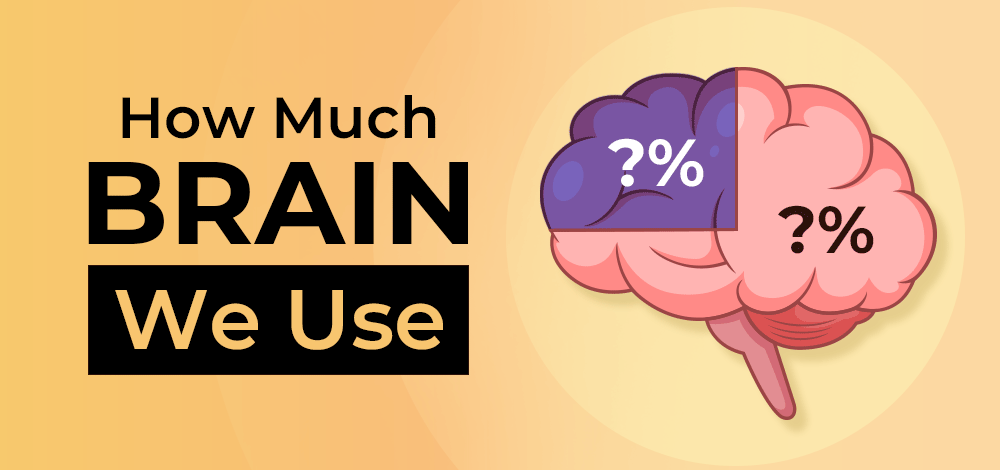The brain is a fantastic thing, not just because it’s the body’s control system—guiding it constantly on what to do, reminding the heart to keep beating—but it’s the wellspring of all of our feelings, a repository of our memories and hard drive of our behavior and self-awareness. It is also known as the most complex organ of the body. But do you know that this organ which carries 100 billion neurons actually functions at only 10% of its capacity? Yes, it’s a popular brain myth that has been going on for a long time.

How Much of Our Brain Do We Use?
You’ve probably heard this myth that we only use a small portion of our brain’s capacity, thanks to movies and self-help books that eternalize this idea. But what’s the truth behind it? In this article, we’ll take a closer look at science and explore the latest research to separate real from the reel. Plus, we’ll debunk some common misconceptions about how much of our brain we actually use.
How Much of Our Brain Do We Use?
It’s commonly known saying that we only just use 10% of our brains, yes, and not all of it.
And if the brain is such a hands-on tool with immense potential, tapping its rest of 90% could make us savants who remember to the twenty-thousandth decimal place or perhaps possess some telekinetic powers. Many movies and educators have in fact built tons of content around this, attracting attention. But is that the fact or just a myth waiting to be busted and/or is already busted by well-known scientists? If not, then can we increase our brain power to become totally limitless?
Related Article – Anatomy of the Brain
Origin Behind 10% of Using Brain
10% of the brain myth has its likely origin in the 19th and early 20th centuries when medical researchers discovered that different parts of the brain perform different activities. In the 1870s, German physiologists Gustav Fritsch and Eduard Hitzig studied a spot in a dog’s brain via electric stimulation.
They surgically removed that part, only to find that dog seemed unaware of it. Over the next half-century, several researchers were eager to zap various parts of the animal and human brains in order to map brain function. But they were only able to understand what a portion, ~10% of the brain did, since on stimulating the rest 90%, they were not able to see any muscles twitching. Since it remained an unknown mystery, that area was labeled the silent cortex.
Non-scientists, with no complete understanding of the research, or maybe mistakenly took this to mean that most of our brain is on a permanent vacation. In the 1890s, Harvard psychologists, William James, and Boris Sidis argued that humans only use a part of their brains. However, neither of their work nor words specify a percentage.
The myth then began gaining currency when in the 1920s, the book “Mind Myths: Exploring Popular Assumptions About the Mind and Brain”, has a chapter on the 10% of the brain myth. During the same period, several self-help advertisements were saying, “There is NO LIMIT to what the human brain can accomplish. Scientists and psychologists tell us we use only 10% of our brains“.
Finally, it became a pet idea and began to be used in several writings. In 1932, writer, John W. Campbell, stated in his short story that “no man in all history ever used even 50% of the thinking part of his brain”. Lowell Thomas put a stamp—in a foreword to Dale Carnegie’s book in 1936, “How to Win Friends and Influence People”—on William James’ unspecified theory, “Professor William James of Harvard used to say that the “average man develops only 10% of his latent mental ability”.
Other than the misused and misplaced words in these writings, there was also a prevalent belief among scientists that neurons make up around 10% of the brain’s cells. This also contributed a tad to the 10% of the brain myth.
Breaking Brain Myth With Evidence
In 2003, science journalist Christopher Wanjek wrote that the silent cortex, or 90% of our brains controls language and abstract thinking, among many other things. Around the same time, many neurologists also presented several pieces of evidence to counteract the 10% of the brain myth.
In a 2008 study by Neurologist Barry Gordon, he described the myth as false, adding, “It turns out though, that we use virtually every part of the brain, and that [most of] the brain is active almost all the time,”.
Neuroscientist Barry Beyerstein who was studying the myth for several years, sets out six kinds of evidence in 2004, refuting the 10% of the brain myth:
1. Studies of Brain Damage
Let’s assume that if we use only 10% of our brains then technically, damage to other areas of our brains should not impair performance. Right? Instead, there is almost no area of our brain whose damage doesn’t have an impact on our other bodily functions. There are profound effects even on the tiniest of damage.
2. Scanning of Brains
Imaging of the brain (with technologies such as positron emission tomography (PET) and functional magnetic resonance imaging (fMRI)) shows that no matter what is our activity, including our unconscious stage or sleep, all brain areas are always active. While some areas are more active at any one time than others, no part of the brain is not functioning, barring the situation of damage to the brain when the brain has some “silent” areas.
3. Size of and Energy Use By Brains
Despite occupying 3% of our body weight, the brain consumes 20% of the body’s energy (including oxygen and nutrients), making it enormously costly to the rest of the body.
The majority of the energy consumed by our brains powers the rapid firing of millions of neurons connecting and communicating with each other, thereby giving rise to all of the brain’s higher functions. The remaining energy the brain uses to control activities that are either unconsciously done such as heart rate or consciously done out of habit such as driving a car.
With so many tasks to perform, how can 90% of our brains be unnecessary, before that how could it have evolved in the first place with so much redundant matter?
4. Localization of Brain Function
Our brains don’t act as a single mass, but rather have distinct regions for different kinds of information processing. No researchers have ever found a function-less area in our brains however, they sometimes are unable to detect the functions performed.
5. Microstructural Analysis
To monitor the activity of a single cell, researchers insert a tiny electrode into the brain, using the single-unit recording technique. If 90% of brain cells were not getting used, wouldn’t this technique reveal that? However, it wasn’t so in the decades of research being done.
6. Synaptic Pruning
There is a process of degeneration that occurs in inactive Brain cells and if 90% were not used, any autopsy of normal adult brains would have to reveal large-scale degeneration.
While it’s true that at any given moment all of the brain’s regions are not concurrently firing, and maybe during our resting periods we are only using 10% of our brains, we do use almost 100% of our brains over 24 hours, just like our body muscles. Even at rest, or in absence of any cognitive task, a widespread brain network is active and synchronized, which means a person likely uses as much of their brain as reasonably possible.
Why Does The 10% of brain Myth Still Persist?
Only due to the misquotation over and over again, through movies, tv-series, and books.
Much acclaimed in 2014, Scarlett Johannson’s film, Lucy showed the story around cerebral capacity and how on achieving it at 100%, one becomes omnipresent. This ain’t the only one, tapping into the extraordinary powers of our brains gained by accessing the silent/hidden parts of it, is a ubiquitous trope in popular culture. Bradley Cooper’s film Limitless, its TV series, and several others like Star Trek, Heroes, Fringe, and beyond.
Neurologist Barry Gordon very aptly states that the durability of the 10% of the brain myth stems from how all of us see our potential, our conceptions about our own brains, and how we see our own shortcomings as evidence of the existence of some untapped gray matter.
We all want to achieve so much more, on not being able to, it’s easier to morph it into the shorthand idea that we use just 10% of our brains.
The truth is we can achieve so much more and unlock that hidden brain potential by keeping ourselves determined and our brains healthy and strong. With proper hydration, sufficient nutrition, and capped resting periods, we can make use of this complex organ, more than we already are.
Conclusion
Even though pop culture has made everyone believe that they’re using 10% of their brain but the myth has been debunked because we use 100% of our brain. To sum up, the idea that we only use a small part of our brain’s power is a false belief. Although we don’t use our whole brain at once, we use a lot of it in our daily lives. This knowledge can help us appreciate how amazing our brain is and what it’s capable of doing. By understanding the truth, we can continue to learn more about our brain and what it can do for us.




